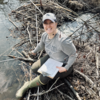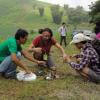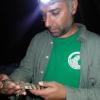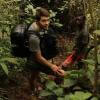Camera traps have been a key part of the conservation toolkit for decades. Remotely triggered video or still cameras allow researchers and managers to monitor cryptic species, survey populations, and support enforcement responses by documenting illegal activities. Increasingly, machine learning is being implemented to automate the processing of data generated by camera traps.
A recent study published showed that, despite being well-established and widely used tools in conservation, progress in the development of camera traps has plateaued since the emergence of the modern model in the mid-2000s, leaving users struggling with many of the same issues they faced a decade ago. That manufacturer ratings have not improved over time, despite technological advancements, demonstrates the need for a new generation of innovative conservation camera traps. Join this group and explore existing efforts, established needs, and what next-generation camera traps might look like - including the integration of AI for data processing through initiatives like Wildlife Insights and Wild Me.
Group Highlights:
Our past Tech Tutors seasons featured multiple episodes for experienced and new camera trappers. How Do I Repair My Camera Traps? featured WILDLABS members Laure Joanny, Alistair Stewart, and Rob Appleby and featured many troubleshooting and DIY resources for common issues.
For camera trap users looking to incorporate machine learning into the data analysis process, Sara Beery's How do I get started using machine learning for my camera traps? is an incredible resource discussing the user-friendly tool MegaDetector.
And for those who are new to camera trapping, Marcella Kelly's How do I choose the right camera trap(s) based on interests, goals, and species? will help you make important decisions based on factors like species, environment, power, durability, and more.
Finally, for an in-depth conversation on camera trap hardware and software, check out the Camera Traps Virtual Meetup featuring Sara Beery, Roland Kays, and Sam Seccombe.
And while you're here, be sure to stop by the camera trap community's collaborative troubleshooting data bank, where we're compiling common problems with the goal of creating a consistent place to exchange tips and tricks!
Header photo: Stephanie O'Donnell
No showcases have been added to this group yet.
- 0 Resources
- 0 Discussions
- 4 Groups
- @fabiola
- | She/her
- 0 Resources
- 0 Discussions
- 5 Groups
- @Markbowler
- | He/Him
University of Suffolk
Wildlife distributions and the effects that human activity has on populations. Spatial ecology of Amazonian mammals through audio and camera surveys. Hunter and gun tracking in Peru. Bats in suburban and agricultural landscapes in the UK

- 0 Resources
- 4 Discussions
- 11 Groups
Wildlife Protection Solutions (WPS)
Software Engineer in Conservation Tech



- 2 Resources
- 15 Discussions
- 10 Groups
- @diego_amazonia
- | He/Him/Él

- 0 Resources
- 2 Discussions
- 1 Groups
- @Palinda
- | He
Corporate Responsibility Specialist & Sustainability/ Climate Change Professional Helping Conservation, Restoration, Community Livelihood Development ESG strategy and Sustainable Development.
- 0 Resources
- 0 Discussions
- 8 Groups
- @Tamara
- | she/hers
Molecular ecologist and eDNA enthusiasist. Mammals, Southern Africa, fish otter, fishes in Europe
- 0 Resources
- 0 Discussions
- 3 Groups
- @cappel
- | she/her
Wildlife Science PhD candidate working on computer vision with camera traps and bioacoustics
- 0 Resources
- 5 Discussions
- 13 Groups
- @valengsb
- | she / her
GIS specialist for Audubon Americas | Biologist with an emphasis on Conservation and Sustainable Development | Innovative approaches in the study and monitoring of biodiversity for possible, biodiverse, and just futures.
- 0 Resources
- 0 Discussions
- 18 Groups
- @Chris_Beirne
- | he/him
I am Director of Wildlife Programs for Osa Conservation: Wildlife | Tech | Conservation


- 3 Resources
- 3 Discussions
- 6 Groups
- @CDean
- | she/her
Grad Student, UW-Stout, Beaver habitat biodiversity research, process based restoration
- 0 Resources
- 7 Discussions
- 6 Groups
Ecologist at Noe NGO, Project manager in restauration, rewilding, and citizen sciences program for grassland ecosystems and wild pollinators

- 0 Resources
- 1 Discussions
- 7 Groups
Article
In 2019, the U.S. Navy initiated a time-lapse camera study to investigate seal presence at select haul-out locations in the lower Chesapeake Bay and coastal waters of Virginia, which are important areas to Navy training...
13 July 2023
Apply for funding (£500,000-£750,000) to develop software systems, which will help to improve biodiversity monitoring by automating the analysis of images and videos
12 July 2023
Applications are now open till 23 July for the 2023 Canon Oceania Grants with the category of the Environmental Grant valued at AU$5,000. The finalist will be selected based on the environmental and social merits of...
7 July 2023
Article
At Appsilon, we are always working to enable our users to get the most out of our solutions. With this in mind, we are happy to introduce two new add-ons to Mbaza AI.
4 July 2023
In this Conservation Tech Showcase case study from Osa Conservation, you’ll learn about how technology is aiding their long-term efforts to prevent wildlife crime, protect critical species, and build a climate-adaptive...
22 June 2023
In this interview between Rob Appleby and Ellie Warren, we discuss the importance of DIY, recycling, and sharing tools in order to make our community more sustainable.
14 June 2023
New insights into the behavior of the large-antlered muntjac, a critically endangered deer species in Southeast Asia, are revealed through camera-trapping, shedding light on scent marking as a communication method used...
12 June 2023
Careers
Permanent and Full Time role at the UK Centre for Ecology & Hydrology
8 June 2023
Acorn removal study of Nendo Dango, Ecological Restoration Research group at the University of Granada
5 June 2023
The saola, also known as the 'Asian unicorn,' remains one of the world's most elusive and rare animals. Conservation organizations, such as the Saola Working Group, operating in Laos and Vietnam, are conducting...
18 May 2023
Camera traps installed in Vietnam's Phong Dien Nature Reserve have yielded remarkable images of rare and endangered species, igniting optimism for biodiversity conservation in the region. Among the captivating...
18 May 2023
This article compares and contrasts the success of their wolf monitoring efforts with both collars and camera traps. The camera traps were intended to help researchers identify individual wolves within the population,...
5 May 2023
August 2025
event
event
September 2025
event
event
event
November 2023
event
58 Products
Recently updated products
4 Products
Recently updated products
| Description | Activity | Replies | Groups | Updated |
|---|---|---|---|---|
| Aloha Luke,This is an amazing tool that you have created. Are your cameras availble for purchase? We use a lot of camera traps in the Hono O Na Pali Natural Area Reserve on Kauai... |
+4
|
AI for Conservation, Autonomous Camera Traps for Insects, Camera Traps | 13 hours 45 minutes ago | |
| @LydiaKatsis Trapper was designed to process large-scale camera trap projects, and it offers two interfaces for data management: a simple citizen science interface and an expert... |
+15
|
Camera Traps | 3 days 3 hours ago | |
| Hello Eugene, I just tried your service:Was wondering how possible will it be to have the option to upload a second image and have a comparison running to let the user know if... |
|
AI for Conservation, Camera Traps, Data management and processing tools, Software Development | 5 days 22 hours ago | |
| Thank you for your reply! It surely helps, we have use exif for a while to read metadata from images, when there is information available. Could be nice to maybe see if we... |
|
AI for Conservation, Camera Traps | 1 week 2 days ago | |
| Hi everyone,I’m currently developing a multilingual, offline-friendly training program called ConTech Curriculum, designed... |
|
Autonomous Camera Traps for Insects, Camera Traps, Conservation Tech Training and Education, Protected Area Management Tools | 1 week 4 days ago | |
| Wow this is amazing! This is how we integrate Biology and Information Technology. |
|
Camera Traps, AI for Conservation, Build Your Own Data Logger Community, Data management and processing tools, Marine Conservation, Protected Area Management Tools, Geospatial | 2 weeks 3 days ago | |
| It's a wildlabs security innovations thermal camera product. We are a new company (The Netherlands), just formed last year. We just have one wildlife customer at the moment in... |
|
Camera Traps | 4 weeks ago | |
| That's great. Thanks! |
|
Camera Traps | 4 weeks 2 days ago | |
| Idles around 2W, peaks a bit more than 6W. |
|
Camera Traps, AI for Conservation | 1 month ago | |
| We have a camera that could do this over some distance away due to a thermal module being involved. It will also record very high quality audio (Nature recording audiophiles rave... |
|
Camera Traps | 1 month ago | |
| Here is a nice review on the use of camera traps in various ecological contexts:https://onlinelibrary.wiley.com/doi/toc/10.1002/(ISSN)2045-7758.ecological-insights |
+10
|
Camera Traps, Data management and processing tools | 1 month 1 week ago | |
| Super nice project! How do you imagine thermal cameras will help with vegetation? It cannot exactly look though it.Rather than placing the camera inside the metalbox have you... |
|
Camera Traps | 1 month 1 week ago |
live streaming to a cell tower
5 July 2021 2:58pm
7 July 2021 11:01pm
Thanks for your quick response. I am definitely interested in your device if I understand correctly. Your device sends the camera feed to the celular network? Telus advertises 4G/5G does that also carry 3G? So I would need a camera, solar panel battery and a celular data plan?
Doug
8 July 2021 4:10am
Hi Doug.
It's actually an interesting application, however it might actually be cheaper to try and put together an off-the-shelf solution rather than go custom. There seem to be some livestreaming trailcams that might give you what you want almost out of the box. The Spartan GoLive trailcam seems like it might do this. Also other animal webcam setups seem to use a combination of WiFi security camera + a WiFi-LTE modem. This might actually be the cheaper and quicker way to go.
I do think that having a cellular streaming camera setup specifically for wildlife is a really interesting design. Trailcams are generally designed for camera trap functionality so I suspect the live functionality would be an afterthought. I'm curious if they have to deal with things like heat and recovering the stream after the communications goes down.
In our designs, we assume a very resource constrained environment, ie: no power sources, little or no connectivity, etc. So looking at a design where it's specifically expecting a power source (ie: dedicated large solar panel) and good/decent cellular connectivity with the design focus on uptime might be something interesting to pursue.
But for now, I recommend checking out the live trailcams or a wifi security cam + LTE bridge setup. And if you're interested in a dedicated solution specifically for wildlife cams, I'd love to discuss what the requirements would be. It might be super useful for wildlife orgs and parks to build awareness and improve funding,as well as benefit the research and conservation community.
Akiba
How do I get started with Megadetector?
 Siyu Yang
Siyu Yang
7 July 2021 12:00am
WILDLABS Tech Tutors: Season 3
6 July 2021 12:00am
How do I choose the right camera trap(s) based on interests, goals, and species?
 Marcella Kelly
Marcella Kelly
6 July 2021 12:00am
How (some) Trail Cameras Fail + how to fix
1 July 2021 6:31pm
3 July 2021 1:45pm
That's such a cool list. Thanks for posting it!
Akiba
Discover new services to improve camera traps' user experience!
24 June 2021 9:09am
Sourcing camera traps in Ukraine - advice needed!
15 June 2021 10:19am
17 June 2021 4:46am
Hi,
Maybe try sourcing from Aliexpress? I an't speak to the quality, but at some price point it becomes worth looking into this option.
-harold
Arboreal camera trapping
8 June 2021 10:56am
10 June 2021 10:19pm
Hi Michelle, I've worked on a few arboreal camera trap surveys so I might be able to share some information. With other researchers we've been working on a paper that reviews the current state of arboreal camera trapping, methods, recommendations, and what to expect in the upcoming years. It's still in review, but I'm sure most, if not all, of the authors will gladly help you with any questions you might have.
I've seen footage of pangolins in canopy cameras (https://twitter.com/rewild/status/1272904442061492226), try contacting @masselouxgarou and @thereal_jayhay on twitter. If you have any specific questions, let me know and perhaps I can point you on the right path!
Tech4Wildlife Leaders: Understanding Endangered Primate Populations
2 June 2021 12:00am
Recommendations needed for recycling batteries in Mexico
31 March 2021 4:12pm
10 May 2021 11:42am
21 May 2021 6:08pm
I just did a quick search and it doesn't look like there's a place where you can ship them in Mexico. However, at least in Mexico City, there are a bunch of collection sites for old electronics and batteries (see below- sorry the link it's in Spanish).
https://www.dineroenimagen.com/hacker/estos-son-los-centros-autorizados-para-tirar-tus-pilas-usadas-en-cdmx/108084
I know you have a lot of batteries, but have you consider taking some back with you? That's what I've been doing with our empty batteries, bring them back from Madagascar to Canada.
Tech4Wildlife Leaders: Resolving Human-Giraffe Conflict
21 May 2021 12:00am
Camera traps in the tropics: no detection of wildlife visits
12 April 2021 9:57am
3 May 2021 9:26am
Hi!
the distance varies depending on where it's possible to position the camera, but the mean distance is around 2.5m. Which for rats might be to distant.
Unfortunately we can't install a cctv system.
Thank you.
7 May 2021 1:33pm
Hi Patricia,
I think this is likely an issue with the PIR lens positioning. The PIR has detection zones that are designed to maximise image capture of things moving a certain distance away.
A quick fix would be to have the camera trap placed directly above the nests looking straight down. I have seen someone doing this on twitter for invasive species on islands but haven't been able to re-find the tweets.
I would use a rat substitute for testing, like a tennis ball on a stick. Warm this up in the sun and then insert into the field of view and check if the camera has captured it. You could try this in different orientations and angles to see where the detection zones might be.
Best wishes,
Sam
8 May 2021 6:19pm
Hello
I understand how frustating that can be....I would try with the camera closer. 2.5m seem too far away for rat...specially that it must have some vegetation between. Also think that the suggestion of putting the camera above the nest facing down is also a great idea...
Best of luck...
Spypoint Force Dark Camera Trap Screen Broken
21 April 2021 9:48am
21 April 2021 2:40pm
Hi.
Apparently it's a common problem with Spypoint cameras. I recommend checking out this thread and testing out the reboot procedure.
Akiba
Recommendations needed: Rechargeable batteries for camera traps
16 February 2021 4:15pm
9 April 2021 3:55pm
I have only used Tenergy NiMH rechargeables, these put out 1.2 V. We've used it on Bushnell Trophycam, which have 2x4 battery sets, i.e. you only need 4 batteries for it to have enough voltage, the additional batteries don't increase the voltage, they only prolong working time. So 4x1.2=4.8 V instead of the expected 6 V from alkaline batteries. I would think that Cuddeback has a similar circuit setup, so an external 12 V battery might actually be too much, as some have already pointed out. With regular NiMH batteries what's most important is to get batteries with high mAh. The ones sold commercially usually have very low mAh, so they won't last very long. We have 2400 mAh, I think, and it works reasonably well, they can last for about a month in the field, IR flash works.
9 April 2021 4:20pm
Hello Akiba
That sounds good!
Do you have a picture of the complete setup?
Bests
Juan
9 April 2021 6:10pm
While the manufacturer might claim that the camera requires 8xAA at 1.5v each, most likely it will work just fine with NiMH batteries that have nominal voltage of 1.2V.
I have used eneloops with Reconnyx cameras for a long time, as well as with handheld GPSes and a myriad of electronic devices and not once run into trouble because of the lower voltage. Your camera should have a setting in the menu to select NiMH batteries, that will prevent it from shutting down too soon.
I suggest you do your own testing - run 2 cameras one next to another on a 1.5V alkaline battery and a 1.2V NiMH rechargeable one until it switches off and check the voltage on the "empty" cell.
Your issue will likely not be the voltage of the cell, but the current the battery can deliver, as it has to recharge a capacitor in the incadescent flash light. I see that the manufacturer declares up to 20s recharge time for night photos, which is a lot. That is a downside of a colour camera.
I don't know what the best source is for batteries in SA, but if possible, get rechargeable batteries from IKEA (Ladda NiMH batteries). They are rebranded eneloops pro for around 30% less and I am yet to find a better battery for a camera trap. Otherwise, like mentioned before, eneloop pro will be hard to beat for performance and reliability.
New Article: Environmental DNA Metabarcoding
6 April 2021 12:00am
I made an open-source tool to help you sort camera trap images
8 February 2021 5:01pm
13 March 2021 2:58pm
Hi seems great and easy to use! Just a question, can the software success to identify the species or "only" categorize animal/ vehicle/human? Can we "trained" the software to detect a specific species?
thank you
13 March 2021 5:54pm
Right now the only classifications are animal/vehicle/person/empty. It cannot discern between different species.
There is no support for training at the moment -- I am envisioning something down the line but I wouldn't say that's coming any time soon.
Hope that helps!
29 March 2021 9:02pm
Hi
I just tried and works great, I will include it in my workflow.
Thanks for your work!
Juan
The 2021 #Tech4Wildlife Photo Challenge: Community Highlights
25 March 2021 12:00am
Wide angle camera trap
17 February 2021 3:51pm
19 March 2021 2:40pm
Important considerations raised by Peter!
In my case it was not important though, as I was using the trap camera in timelapse mode.
19 March 2021 3:42pm
I agree the PIR sensor and the camera will be "seeing" different pictures, but I believe that is exactly the effect that is sought: now too much of the elephant is out of the frame when the camera is triggered, and the wide angle lens is desired so that more of the elephant would fit in the frame at that same triggering point.
19 March 2021 6:51pm
In the TrailCamPro link above (comparing FOV and Detection Angle), I see a few "panorama" camera models. For example, the Moultrie 150i or Moultrie 180 (https://www.moultriefeeders.com/catalogsearch/result/?q=panoramic) - although they are all listed as discontinued.
It seems this might be a solution for Daniela's scenario.
I'm also interested because it could offer more forgiving setup (if the subject does not travel exactly where expected.)
Has anyone here worked with a panoramic camera? What did you find to be their pros/cons?
Kaggle Competition: iWildcam 2021 - FGVC8
12 March 2021 12:00am
Funding Opportunity: COVID-19 Science Fund
10 March 2021 12:00am
Resource: WildID
8 March 2021 12:00am
Seeing #Tech4Wildlife With Unseen Empire
8 March 2021 12:00am
Virtual Event: Carnivores and Camera Traps
4 March 2021 12:00am
Collaboration Spotlight: BoomBox
 Ellie Warren
and 2 more
Ellie Warren
and 2 more
26 February 2021 12:00am
Wireless Camera for Live Viewing
23 December 2020 11:53pm
20 February 2021 3:04am
Look forward to playing with it when mine arrives I have a sd card arduino module also not finding much documentation on how to hook it up so was going to play with a server and see what I can do with it and photos
20 February 2021 4:06am
Nice! I'm building an esp32-cam with a Pi Zero server and I have the photos sending to it now. The last step is to build a housing for it and get it outside to capture some photos of the bears coming out of hibernation. Should be fun! I'm hoping to download photos from the camera over 1km away from my house, while sipping tea haha.
20 February 2021 5:31am
I have a raspberry pi3 setup now as a video streaming server so I can keep a eye on my home while I am at work
Open Source Camera Trap
24 January 2021 7:22pm
25 January 2021 4:41am
Akiba I have used ubiquiti loco m5 to broadcast internet with great success when I was setting up internet for a park for a 10k run I was able to get atleast a mile with no issues with internet
not discorcuaged just looking to piggy back off of a local wifi and be able to connect to a diy camera trap and be able to either do live video feed or capture a pic and then with a program I create send it to email or txt message
the place I am looking at I can get almost a mile in distance but the problem is the power it would have to be some kind of solar power don't want to have to change batteries ever other day
31 January 2021 10:06pm
Something I'm working on that might work well for you and is super affordable at about $30 per camera.
ESP32-cam (not super high quality photos though) with a motion sensor and it sends the photos to a PI Zero W that can be accesses at any time via wifi. I'm using the TPlink portable but have found that WemosD1 boards and upgrading the firmware to be able to do wifi repeaters works well.
Here's the camera I'm using:
https://starairvision.com/esp32-cam-motion-camera-with-date-and-time/
I'll make a post on here when the full project is built and I've tested the range. The repeaters use something called mesh networking. You can have a number of them in a row to get the camera out into the forest. Or if you have lign of sight you can use a signal booster and or a directional antenna.
31 January 2021 11:39pm
Thanks Ryan would like to hear more about this, the project look awesome what distance are you getting from your wifi router
Tech Tutors: How do I start a Tech4Wildlife collaboration?
28 January 2021 12:55pm
28 January 2021 6:22pm
One barrier that was discussed in the presentation was the "risk" or uncertainty of a payoff when talking to potential funders. It seems to me that the "risk" factor of collaborations like this, for funders, would be analogous to the investment and payoff when developing a genomics program. Relative to traditional field research, it takes a much greater investment in time, with different expertise, to create a reference genome for a species of interest and then pull SNPs, etc. Nevertheless, funders seem to recognize the potential for genomic research and genomic tools. Do you think that greater openness to “risk” in conservation genomics results from closer intellectual proximity (i.e., molecular biology vs organismal biology), or to conservation genomics being a more mature field (i.e., more examples of success), or to other factors? If intellectual proximity is a key factor, then conservation tech collaborations will continue to face this barrier, but if lack of successful examples are a key factor, then perhaps this barrier will become less of an issue for conservation tech in the future. Thoughts?
30 January 2021 2:26am
Hi. Just watched the Youtube version (I'm in the unable to watch live hemisphere) and wanted to say that was a great talk. I wish it could have gone for another hour. I liked hearing about the issues and concerns from Melanie on the biology/ecology side. Also could totally relate to what Ed was talking about from the tech side about how it's difficult to have long term collaborations since there isn't really a conservation technology career path at the moment.
I think one of the things we're trying to do with courses like Build Your Own Datalogger is to get people involved in wildlife/conservation side more comfortable with the tech. The goal is to hopefully build a shared repository of technical knowledge that people in the wildlife community can contribute to and benefit from.
Akiba
Protecting Wildlife with Machine Learning
29 January 2021 12:00am
Online thermal imaging courses from the Bat Conservation Trust
26 January 2021 12:00am
Eurasian Otter Workshop to highlight Conservation Planning, Threats, and Research Advances for Monitoring Otter Populations
25 January 2021 5:09pm












































































6 July 2021 2:53am
Hi Doug.
We often work in remote areas like rainforests, desert, Australian outback, etc so we often have to develop custom hardware. We haven't seen anything that fits our needs in a budget range that could accomodate the projects that we work on.
We've since gottenr requests to make the devices publicly available but are still working on finding time to document and set up the manufacturing for them.
However you may be interested in one of the designs we've been using in the Middle East and Australian outback. It's for 3G cellular communications and has inputs for a solar panel and rechargeable batteries. We're manly using it to connect periodically to a cell tower and upload data it collects from other wireless devces (LoRa) in the area. But you can also use it for streaming if your solar/battery capacity is large enough.
If you're interested us, please direct message us on WildLABS and we can discuss more and perhaps set you up for pre-release hardware. I've included some pics below:
Akiba